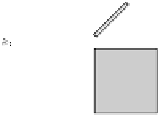Information Technology Reference
In-Depth Information
becomes two-dimensional, i.e. it is a matrix. Moreover, it is worth noting that due to
orthogonality of the core tensor
Z
in (7),
T
h
are also orthogonal. Hence,
T
h
in
decomposition (6) constitute a basis. This is a very important result which allows
construction of classifiers based on the HOSVD decomposition. Such a scheme is
used in the proposed system for RS classification, although other tensor constructions
with simultaneous data compression are also possible [19]. Nevertheless, in our case
each set of prototypes for a
single
sign (i.e. a single class) is independently encoded as
a separate tensor
T
s
. This allows different numbers of prototypes in each of the
classes. As alluded to previously, in each case the series (6) is usually truncated to the
first
N
N
P
most prominent components. In other words, a smaller but dominating
N
dimensional subspace is used to approximate
T
.
≤
T
T
T
T
Fig. 2.
Visualization of the tensor decomposition given by (6)
The series of
k-mode
products (7) can be equivalently represented in a matrix
notation after tensor flattening
T
⎡
⎤
TSZSS SSS S
=
⊗
⊗⊗ ⊗⊗ ⊗⊗
,
(8)
…
…
()
()
⎣
⎦
k
k
+
1
k
+
2
P
1
2
k
−
1
k
k
where
denotes the Kronecker product. This provides us with a convenient link to
the matrix representation of tensor equations which is discussed in the next section of
this paper. By the same token, and taking into an account that
S
k
are orthogonal,
computation of the core tensor
Z
can be expressed as
⊗
T
k
⎡
⎤
ZSTSS SSS S
=
⊗
⊗
⊗
⊗
⊗
⊗
⊗
.
…
…
(9)
⎣
⎦
()
()
k
+
1
k
+
2
P
1
2
k
−
1
k
k
The HOSVD successively applies the matrix SVD decomposition to each of the
flattened
T
(
k
)
versions of the input tensor
T
. In result the
S
k
matrices are
computed [16]. In the 3D case and considering (9), the HOSVD can be written as
()
(
)
T
ZSTSS
.
=
⊗
(10)
()
1
2
3
1
1
As mentioned, in our framework the original tensor
T
i
of a class
i
is obtained from the
available exemplars of the prototype patterns for that class
i
. These, in turn, are
obtained from the patterns cropped from the real traffic images which are additionally
rotated in a given range (in our examples this was ±12° with a step of 2°) with































Search WWH ::

Custom Search